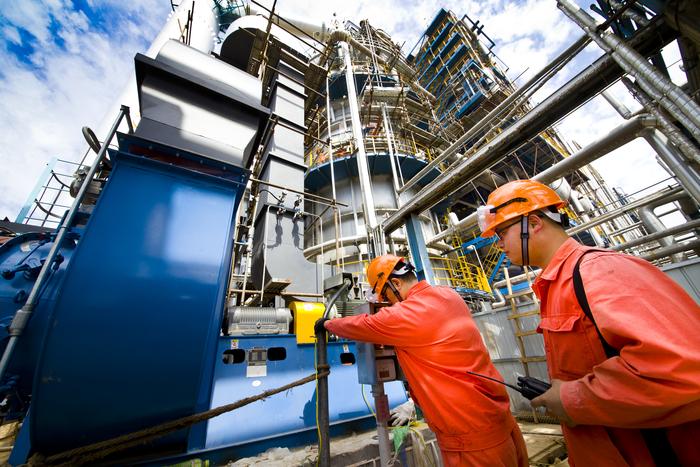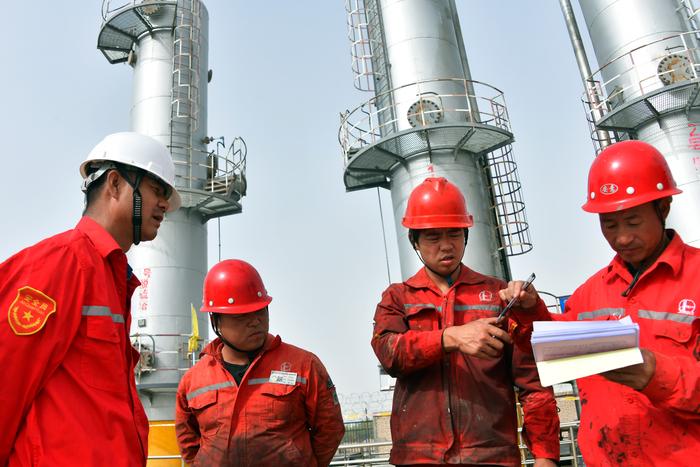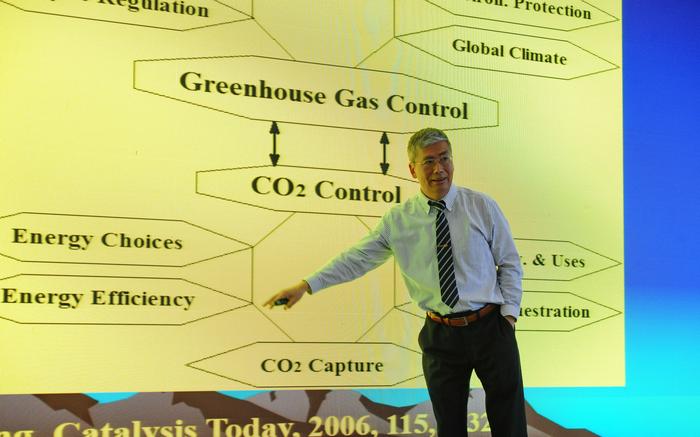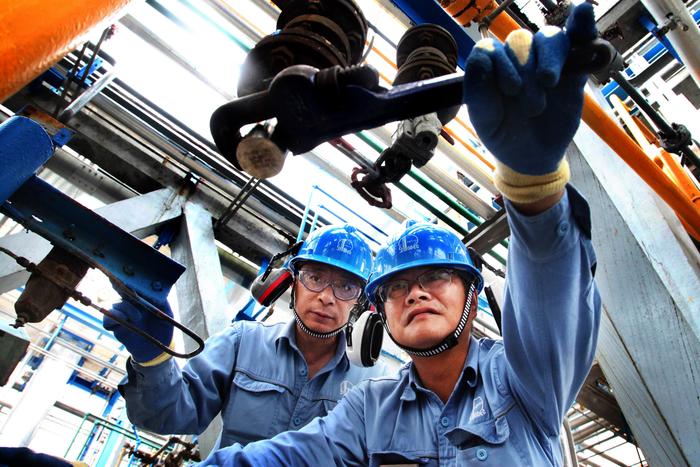|
| 2019-06-24 来源: 中国石化新闻网 |
| 石化新闻 |
|
中国石化新闻网讯 据世界石油网6月21日莫斯科报道, MIPT、Skoltech、俄罗斯科学院高温联合研究所和莫斯科罗蒙诺索夫国立大学的研究人员提供了一种新的石油成分分析方法。他们使用高温高压将油溶解在水中并分析其成分。新方法符合绿色化学原则,因为它可以避免使用对环境有害的溶剂。该论文发表在分析化学和生物分析化学杂志上。 原油几乎从未以原始形式使用。但是,为使精炼尽可能高效,必须知道其精确组成。原油由超过10万种化合物组成,样品的确切成分因其提取场所不同而有所差别。原油的极端复杂性使其不可能分离成单独的化合物。较重的馏分在300摄氏度下是非挥发性的,尚未得到适当的研究。已知它们主要由酚、酮、咔唑、吡啶、喹啉,二苯并呋喃和羧酸组成。除此之外,来自某些油田的原油也可能含有硫化合物。许多烃类化合物具有相同的分子式,相同数量的碳,氢和氧原子,但它们的排列不同,即它们是异构体。 截然不同的结构显然表现出不同的化学性质。高烃化合物由许多原子组成,这意味着每种化合物具有更多的结构可变性。 质谱法提供有关物质的元素组成及其分子量的信息,但通常无法区分不同的异构体。这些信息可以通过同位素交换分析获得。该方法基于以下事实:取决于哪种特定化合物构成原油或一些其他样品,氧原子和氢原子将或多或少地需要时间才能被它们的同位素所取代 – 本质上是相同的元素,但具有不同的质量。水是最容易获得的,也是最清洁的同位素来源,但在正常条件下油不溶于水,因此必须使用强效酸和碱来替代。但酸往往会分解有机化合物,特别是在高温下,从而改变了样品的成分。 然而,已知不溶于水的化合物可以在明显超过100℃的温度下溶解于过热或超临界水中,因此决定将该方法应用于原油。研究人员证明,通过提高温度和压力可以获得水基原油溶液并分析其成分。在高于300atm的压力下将样品在重水(其中氢被氘代替)中加热至360℃,持续1小时。 研究人员比较了同位素交换反应后原始样品和样品的质谱。收集的数据有助于获得关于组成原油的化合物结构的更多信息。该方法可用于在分子水平上研究其他复杂的非极性化合物。 来自Skoltech和MIPT 的教授,同样也是Skoltech质谱实验室的负责人Eugene Nikolaev说道:“同位素标记可能只被纳入分子中的特定位置,类似于锁-钥模型,在不可能使用其他方法来分离单个化合物和识别它们的结构的情况下,我们可以通过使用高分辨率质谱法分析分子结构来测量交换率。” 该论文的作者之一,Skoltech和MIPT实验室的高级研究员Yury Kostyukevich说:“轻质原油储备正在枯竭。燃料油的加氢裂化,其特点为高度复杂和分子结构研究不足,在汽油生产中发挥着越来越大的作用。加氢裂化装置价格昂贵,不在俄罗斯生产,需要使用特殊的催化剂。我们已经找到了一种方法来识别原油中的呋喃、吡啶和环烷酸,而不必采用复杂的蒸馏工艺,我们希望我们的研究将有助于更好地了解原油结构和成分,有助于开发新的催化剂,以提高炼油效率和改善干线管道系统的油质监测。” 裘寅 编译自 世界石油 原文如下: Scientists dissolve crude oil in water to study its composition Researchers from MIPT, Skoltech, the Joint Institute for High Temperatures of the Russian Academy of Sciences, and Lomonosov Moscow State University have offered a new approach to oil composition analysis. They used high temperature and pressure to dissolve oil in water and analyze its composition. The new method is compliant with the green chemistry principle as it makes it possible to avoid using environmentally hazardous solvents. The paper was published in the Analytical and Bioanalytical Chemistry journal. Crude oil is almost never utilized in its raw form. It is necessary, however, to know its precise composition to make refining as efficient as possible. Crude oil consists of over 100,000 compounds, with the exact composition of the sample varying based on the field it was extracted at. The extreme complexity of crude oil makes it impossible to separate into individual compounds. Heavier fractions, which are nonvolatile at 300 degrees Celsius, are yet to be properly studied. It is known that they consist chiefly of phenols, ketones, carbazoles, pyridines, quinolines, dibenzofurans, and carboxylic acids. In addition to that, crude oil from some fields may also contain sulphuric compounds. Many hydrocarbons have identical formulas, with the same number of carbon, hydrogen, and oxygen atoms, but differ in their arrangements, i.e., they are isomers. The vastly different structures obviously exhibit different chemical properties. Heavier hydrocarbons consist of many atoms, which means more structural variability for each compound. Mass spectrometry provides information on the elemental composition of substances and their molecular mass but often fails to distinguish between different isomers. Such information may be obtained through isotope exchange analysis. This method is based on the fact that, depending on which particular compounds constitute crude oil or some other sample, oxygen and hydrogen atoms will take more or less time to be replaced with their isotopes — essentially the same elements, but with a different mass. Water is the most readily available and the cleanest source of isotopes, but oil is insoluble in water under normal conditions so potent acids and alkali have to be used instead. But acids tend to break down organic compounds, especially at high temperatures, thus altering the sample’s composition. It is known, however, that compounds insoluble in water may be dissolved in superheated, or supercritical, water at temperatures significantly over 100 C, so it was decided to apply this method to crude oil. The researchers proved it was possible to achieve a water-based crude oil solution by increasing the temperature and pressure and analyzed its composition. The sample was heated to 360 C in heavy water (in which the hydrogen is replaced with deuterium) at a pressure above 300 atm for one hour. The researchers compared mass spectra of the original sample and the sample after the isotope exchange reaction. The data collected helped obtain more information on the structure of the compounds comprising crude oil. This method may be used to study other complex nonpolar compounds at the molecular level. “Isotope labels may only be incorporated at specific positions in the molecule, similar to the lock-and-key model,” said Professor of Skoltech and MIPT Eugene Nikolaev, who also heads the Laboratory of Mass Spectrometry at Skoltech. “We can analyze molecular structure by using high-resolution mass spectrometry to measure the exchange rate even when it is impossible to separate individual compounds and identify their structure with other methods.” “Light crude oil reserves are depleting. Hydrocracking of fuel oil, which is characterized by its highly complex and poorly studied molecular structure, is playing an ever greater role in gasoline production. Hydrocrackers are expensive, they are not produced in Russia, and they require the use of special catalysts. We have found a way to identify furans, pyridines, and naphthenic acids in crude oil without having to resort to the complex distillation process,” says Yury Kostyukevich, one of the authors of the paper and a senior researcher at Skoltech and MIPT laboratories. “We hope our research will help better understand crude oil structure and composition, contribute to the development of new catalysts for more efficient oil refining, and enable improved oil quality monitoring in trunk pipeline systems.”
|








